Strategic Analysis of Australia Post: Industry and Competitive Threats
VerifiedAdded on 2023/01/18
|11
|3062
|80
Report
AI Summary
This report provides a comprehensive strategic analysis of Australia Post, examining its macro-environment, industry dynamics, competitive threats, and internal strategies. The analysis includes a review of the company's government business enterprise status, its core competencies in logistics, and its evolving strategies to adapt to the changing landscape of the postal service industry, including the rise of e-commerce. The report also assesses the competitive landscape, identifying key players and their impact on Australia Post's market share. Furthermore, the study highlights the company's current strategies, including its focus on customer-centric approaches, e-commerce delivery, and digital services, and offers recommendations for future growth and sustainable competitive advantage, such as technological advancements, diversification, and enhanced research and development to counter market share loss.
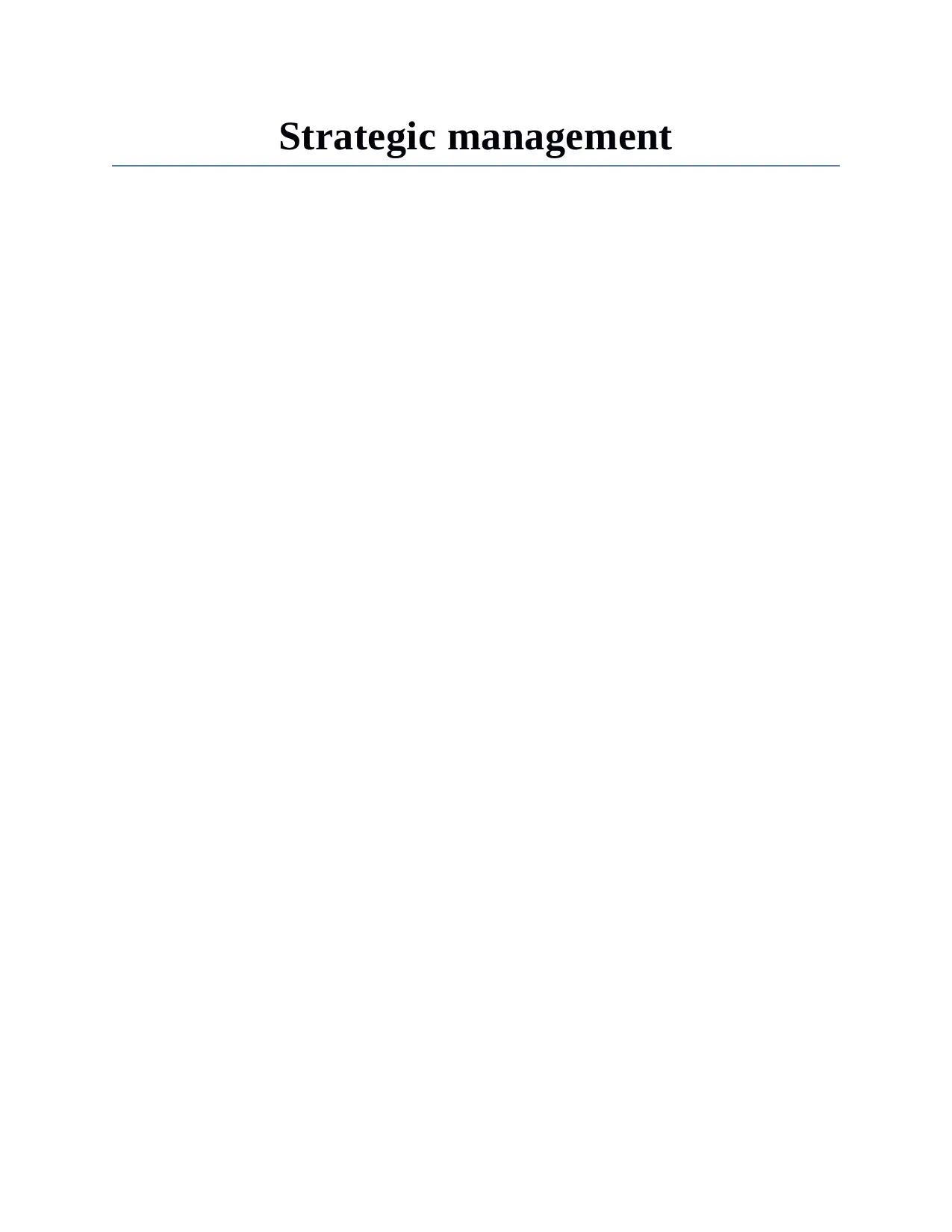
Strategic management
Paraphrase This Document
Need a fresh take? Get an instant paraphrase of this document with our AI Paraphraser
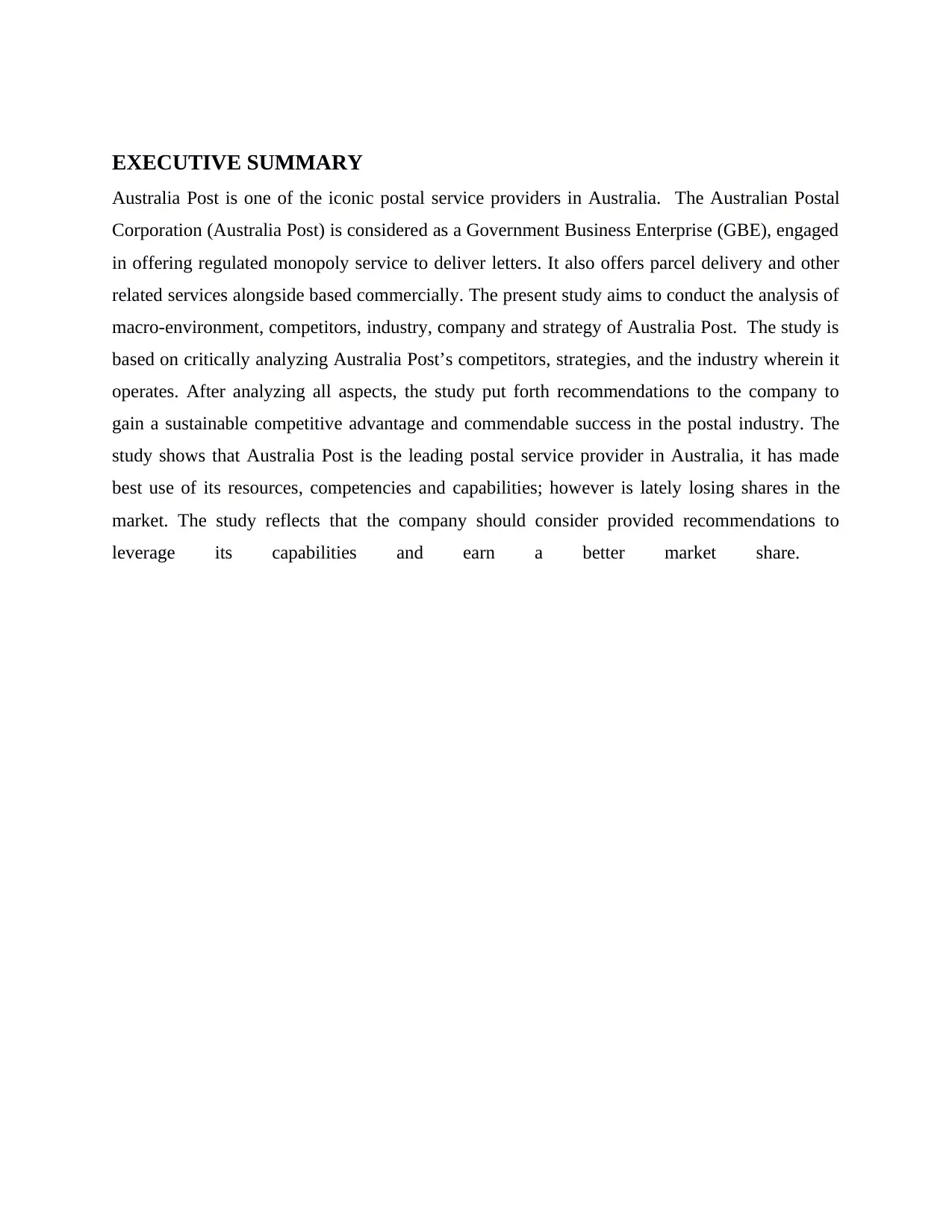
EXECUTIVE SUMMARY
Australia Post is one of the iconic postal service providers in Australia. The Australian Postal
Corporation (Australia Post) is considered as a Government Business Enterprise (GBE), engaged
in offering regulated monopoly service to deliver letters. It also offers parcel delivery and other
related services alongside based commercially. The present study aims to conduct the analysis of
macro-environment, competitors, industry, company and strategy of Australia Post. The study is
based on critically analyzing Australia Post’s competitors, strategies, and the industry wherein it
operates. After analyzing all aspects, the study put forth recommendations to the company to
gain a sustainable competitive advantage and commendable success in the postal industry. The
study shows that Australia Post is the leading postal service provider in Australia, it has made
best use of its resources, competencies and capabilities; however is lately losing shares in the
market. The study reflects that the company should consider provided recommendations to
leverage its capabilities and earn a better market share.
Australia Post is one of the iconic postal service providers in Australia. The Australian Postal
Corporation (Australia Post) is considered as a Government Business Enterprise (GBE), engaged
in offering regulated monopoly service to deliver letters. It also offers parcel delivery and other
related services alongside based commercially. The present study aims to conduct the analysis of
macro-environment, competitors, industry, company and strategy of Australia Post. The study is
based on critically analyzing Australia Post’s competitors, strategies, and the industry wherein it
operates. After analyzing all aspects, the study put forth recommendations to the company to
gain a sustainable competitive advantage and commendable success in the postal industry. The
study shows that Australia Post is the leading postal service provider in Australia, it has made
best use of its resources, competencies and capabilities; however is lately losing shares in the
market. The study reflects that the company should consider provided recommendations to
leverage its capabilities and earn a better market share.
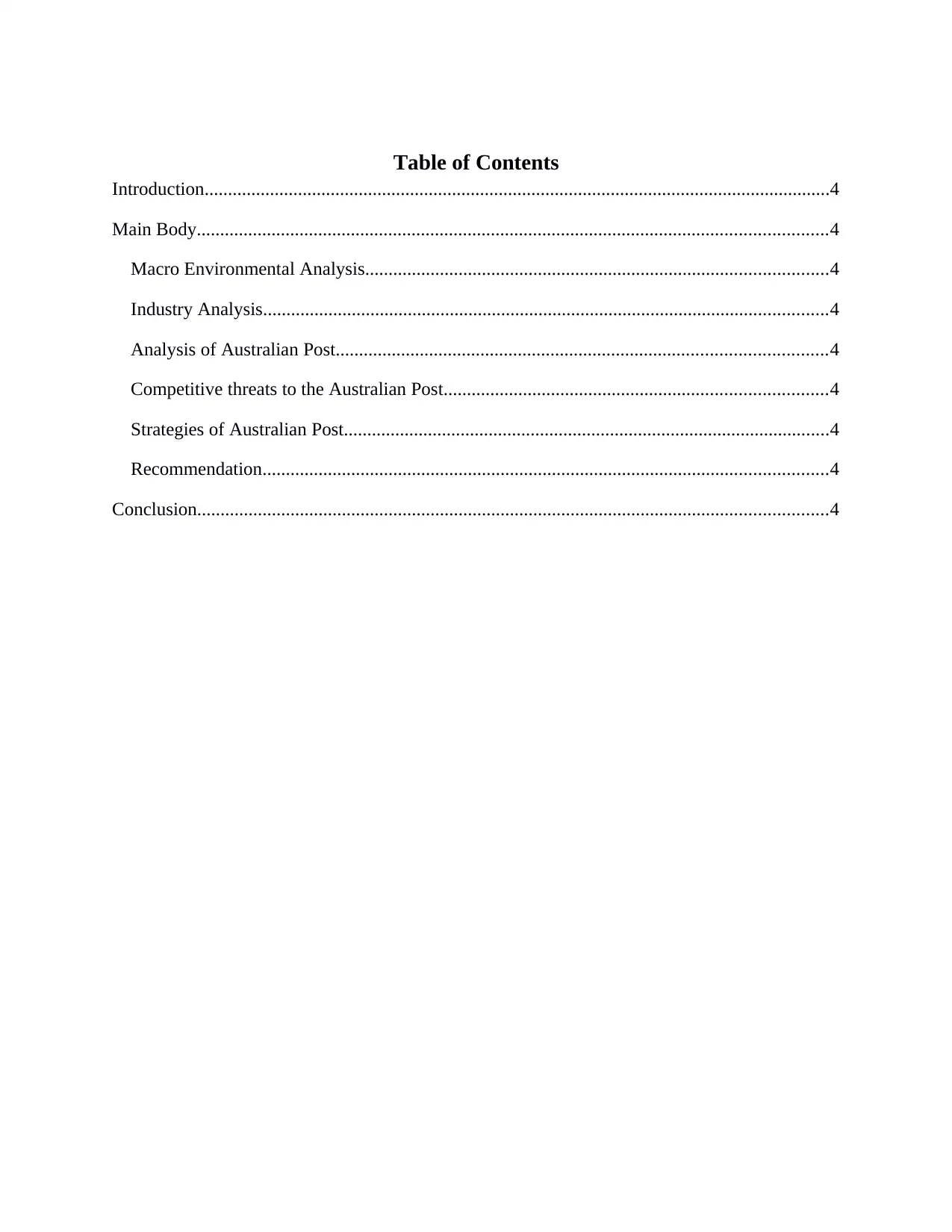
Table of Contents
Introduction......................................................................................................................................4
Main Body.......................................................................................................................................4
Macro Environmental Analysis...................................................................................................4
Industry Analysis.........................................................................................................................4
Analysis of Australian Post.........................................................................................................4
Competitive threats to the Australian Post..................................................................................4
Strategies of Australian Post........................................................................................................4
Recommendation.........................................................................................................................4
Conclusion.......................................................................................................................................4
Introduction......................................................................................................................................4
Main Body.......................................................................................................................................4
Macro Environmental Analysis...................................................................................................4
Industry Analysis.........................................................................................................................4
Analysis of Australian Post.........................................................................................................4
Competitive threats to the Australian Post..................................................................................4
Strategies of Australian Post........................................................................................................4
Recommendation.........................................................................................................................4
Conclusion.......................................................................................................................................4
⊘ This is a preview!⊘
Do you want full access?
Subscribe today to unlock all pages.

Trusted by 1+ million students worldwide
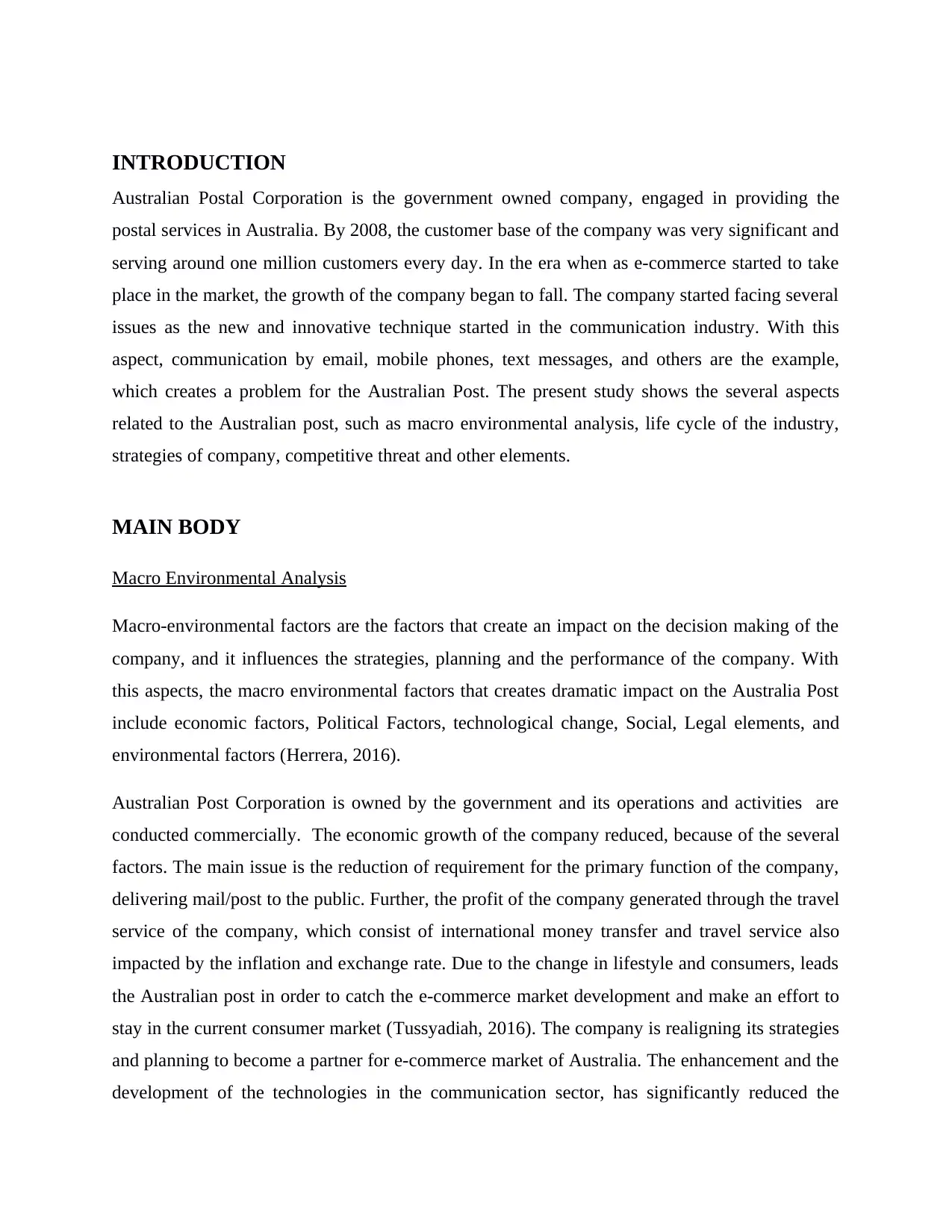
INTRODUCTION
Australian Postal Corporation is the government owned company, engaged in providing the
postal services in Australia. By 2008, the customer base of the company was very significant and
serving around one million customers every day. In the era when as e-commerce started to take
place in the market, the growth of the company began to fall. The company started facing several
issues as the new and innovative technique started in the communication industry. With this
aspect, communication by email, mobile phones, text messages, and others are the example,
which creates a problem for the Australian Post. The present study shows the several aspects
related to the Australian post, such as macro environmental analysis, life cycle of the industry,
strategies of company, competitive threat and other elements.
MAIN BODY
Macro Environmental Analysis
Macro-environmental factors are the factors that create an impact on the decision making of the
company, and it influences the strategies, planning and the performance of the company. With
this aspects, the macro environmental factors that creates dramatic impact on the Australia Post
include economic factors, Political Factors, technological change, Social, Legal elements, and
environmental factors (Herrera, 2016).
Australian Post Corporation is owned by the government and its operations and activities are
conducted commercially. The economic growth of the company reduced, because of the several
factors. The main issue is the reduction of requirement for the primary function of the company,
delivering mail/post to the public. Further, the profit of the company generated through the travel
service of the company, which consist of international money transfer and travel service also
impacted by the inflation and exchange rate. Due to the change in lifestyle and consumers, leads
the Australian post in order to catch the e-commerce market development and make an effort to
stay in the current consumer market (Tussyadiah, 2016). The company is realigning its strategies
and planning to become a partner for e-commerce market of Australia. The enhancement and the
development of the technologies in the communication sector, has significantly reduced the
Australian Postal Corporation is the government owned company, engaged in providing the
postal services in Australia. By 2008, the customer base of the company was very significant and
serving around one million customers every day. In the era when as e-commerce started to take
place in the market, the growth of the company began to fall. The company started facing several
issues as the new and innovative technique started in the communication industry. With this
aspect, communication by email, mobile phones, text messages, and others are the example,
which creates a problem for the Australian Post. The present study shows the several aspects
related to the Australian post, such as macro environmental analysis, life cycle of the industry,
strategies of company, competitive threat and other elements.
MAIN BODY
Macro Environmental Analysis
Macro-environmental factors are the factors that create an impact on the decision making of the
company, and it influences the strategies, planning and the performance of the company. With
this aspects, the macro environmental factors that creates dramatic impact on the Australia Post
include economic factors, Political Factors, technological change, Social, Legal elements, and
environmental factors (Herrera, 2016).
Australian Post Corporation is owned by the government and its operations and activities are
conducted commercially. The economic growth of the company reduced, because of the several
factors. The main issue is the reduction of requirement for the primary function of the company,
delivering mail/post to the public. Further, the profit of the company generated through the travel
service of the company, which consist of international money transfer and travel service also
impacted by the inflation and exchange rate. Due to the change in lifestyle and consumers, leads
the Australian post in order to catch the e-commerce market development and make an effort to
stay in the current consumer market (Tussyadiah, 2016). The company is realigning its strategies
and planning to become a partner for e-commerce market of Australia. The enhancement and the
development of the technologies in the communication sector, has significantly reduced the
Paraphrase This Document
Need a fresh take? Get an instant paraphrase of this document with our AI Paraphraser
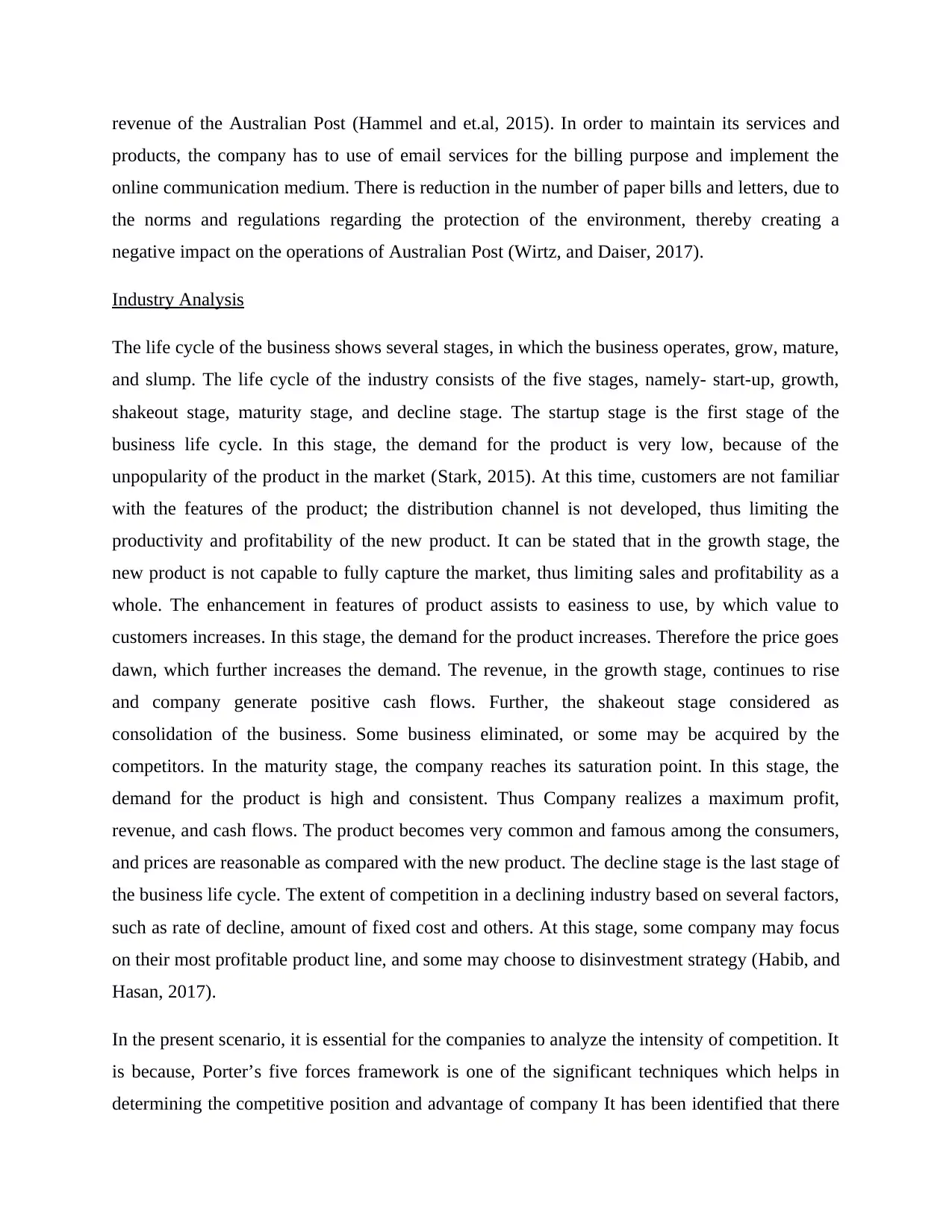
revenue of the Australian Post (Hammel and et.al, 2015). In order to maintain its services and
products, the company has to use of email services for the billing purpose and implement the
online communication medium. There is reduction in the number of paper bills and letters, due to
the norms and regulations regarding the protection of the environment, thereby creating a
negative impact on the operations of Australian Post (Wirtz, and Daiser, 2017).
Industry Analysis
The life cycle of the business shows several stages, in which the business operates, grow, mature,
and slump. The life cycle of the industry consists of the five stages, namely- start-up, growth,
shakeout stage, maturity stage, and decline stage. The startup stage is the first stage of the
business life cycle. In this stage, the demand for the product is very low, because of the
unpopularity of the product in the market (Stark, 2015). At this time, customers are not familiar
with the features of the product; the distribution channel is not developed, thus limiting the
productivity and profitability of the new product. It can be stated that in the growth stage, the
new product is not capable to fully capture the market, thus limiting sales and profitability as a
whole. The enhancement in features of product assists to easiness to use, by which value to
customers increases. In this stage, the demand for the product increases. Therefore the price goes
dawn, which further increases the demand. The revenue, in the growth stage, continues to rise
and company generate positive cash flows. Further, the shakeout stage considered as
consolidation of the business. Some business eliminated, or some may be acquired by the
competitors. In the maturity stage, the company reaches its saturation point. In this stage, the
demand for the product is high and consistent. Thus Company realizes a maximum profit,
revenue, and cash flows. The product becomes very common and famous among the consumers,
and prices are reasonable as compared with the new product. The decline stage is the last stage of
the business life cycle. The extent of competition in a declining industry based on several factors,
such as rate of decline, amount of fixed cost and others. At this stage, some company may focus
on their most profitable product line, and some may choose to disinvestment strategy (Habib, and
Hasan, 2017).
In the present scenario, it is essential for the companies to analyze the intensity of competition. It
is because, Porter’s five forces framework is one of the significant techniques which helps in
determining the competitive position and advantage of company It has been identified that there
products, the company has to use of email services for the billing purpose and implement the
online communication medium. There is reduction in the number of paper bills and letters, due to
the norms and regulations regarding the protection of the environment, thereby creating a
negative impact on the operations of Australian Post (Wirtz, and Daiser, 2017).
Industry Analysis
The life cycle of the business shows several stages, in which the business operates, grow, mature,
and slump. The life cycle of the industry consists of the five stages, namely- start-up, growth,
shakeout stage, maturity stage, and decline stage. The startup stage is the first stage of the
business life cycle. In this stage, the demand for the product is very low, because of the
unpopularity of the product in the market (Stark, 2015). At this time, customers are not familiar
with the features of the product; the distribution channel is not developed, thus limiting the
productivity and profitability of the new product. It can be stated that in the growth stage, the
new product is not capable to fully capture the market, thus limiting sales and profitability as a
whole. The enhancement in features of product assists to easiness to use, by which value to
customers increases. In this stage, the demand for the product increases. Therefore the price goes
dawn, which further increases the demand. The revenue, in the growth stage, continues to rise
and company generate positive cash flows. Further, the shakeout stage considered as
consolidation of the business. Some business eliminated, or some may be acquired by the
competitors. In the maturity stage, the company reaches its saturation point. In this stage, the
demand for the product is high and consistent. Thus Company realizes a maximum profit,
revenue, and cash flows. The product becomes very common and famous among the consumers,
and prices are reasonable as compared with the new product. The decline stage is the last stage of
the business life cycle. The extent of competition in a declining industry based on several factors,
such as rate of decline, amount of fixed cost and others. At this stage, some company may focus
on their most profitable product line, and some may choose to disinvestment strategy (Habib, and
Hasan, 2017).
In the present scenario, it is essential for the companies to analyze the intensity of competition. It
is because, Porter’s five forces framework is one of the significant techniques which helps in
determining the competitive position and advantage of company It has been identified that there
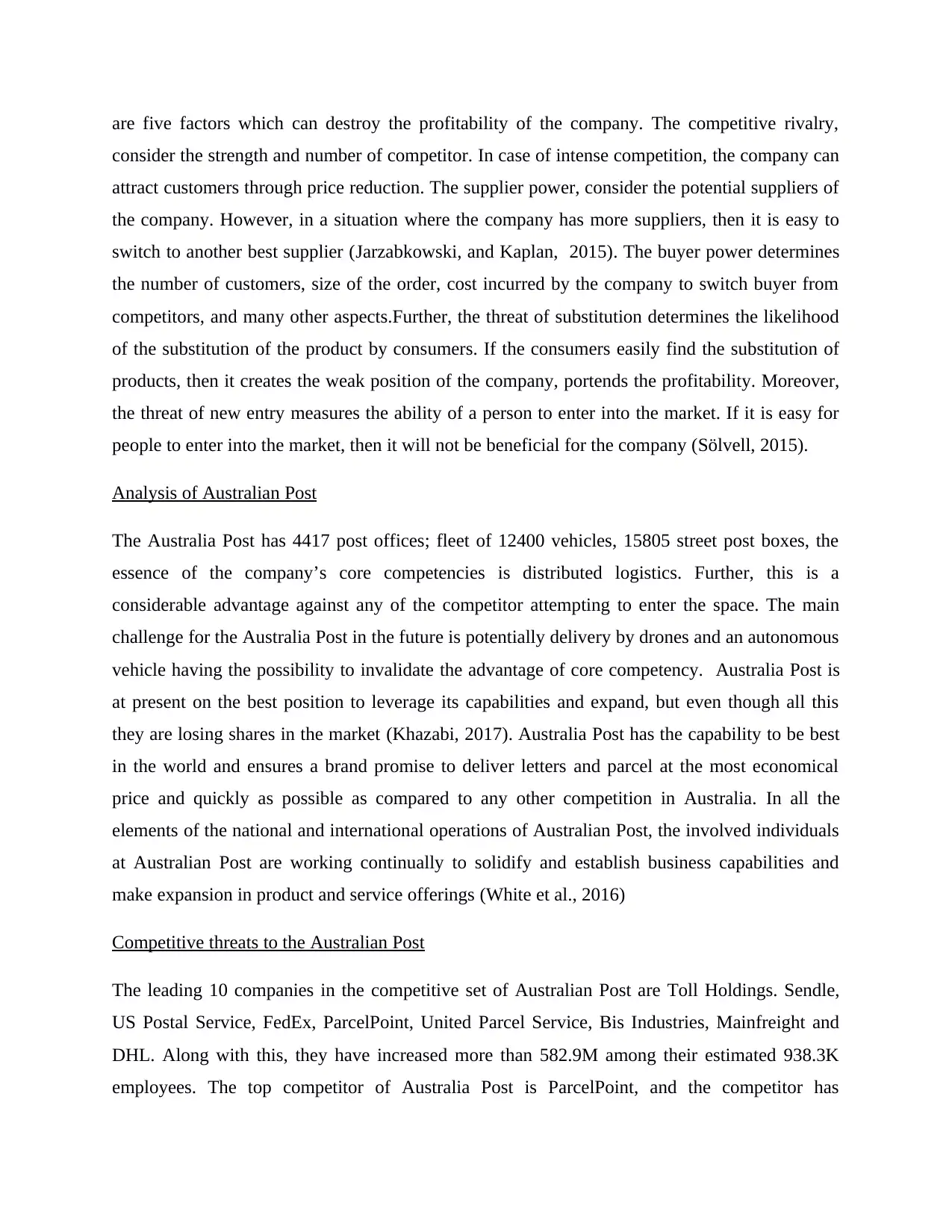
are five factors which can destroy the profitability of the company. The competitive rivalry,
consider the strength and number of competitor. In case of intense competition, the company can
attract customers through price reduction. The supplier power, consider the potential suppliers of
the company. However, in a situation where the company has more suppliers, then it is easy to
switch to another best supplier (Jarzabkowski, and Kaplan, 2015). The buyer power determines
the number of customers, size of the order, cost incurred by the company to switch buyer from
competitors, and many other aspects.Further, the threat of substitution determines the likelihood
of the substitution of the product by consumers. If the consumers easily find the substitution of
products, then it creates the weak position of the company, portends the profitability. Moreover,
the threat of new entry measures the ability of a person to enter into the market. If it is easy for
people to enter into the market, then it will not be beneficial for the company (Sölvell, 2015).
Analysis of Australian Post
The Australia Post has 4417 post offices; fleet of 12400 vehicles, 15805 street post boxes, the
essence of the company’s core competencies is distributed logistics. Further, this is a
considerable advantage against any of the competitor attempting to enter the space. The main
challenge for the Australia Post in the future is potentially delivery by drones and an autonomous
vehicle having the possibility to invalidate the advantage of core competency. Australia Post is
at present on the best position to leverage its capabilities and expand, but even though all this
they are losing shares in the market (Khazabi, 2017). Australia Post has the capability to be best
in the world and ensures a brand promise to deliver letters and parcel at the most economical
price and quickly as possible as compared to any other competition in Australia. In all the
elements of the national and international operations of Australian Post, the involved individuals
at Australian Post are working continually to solidify and establish business capabilities and
make expansion in product and service offerings (White et al., 2016)
Competitive threats to the Australian Post
The leading 10 companies in the competitive set of Australian Post are Toll Holdings. Sendle,
US Postal Service, FedEx, ParcelPoint, United Parcel Service, Bis Industries, Mainfreight and
DHL. Along with this, they have increased more than 582.9M among their estimated 938.3K
employees. The top competitor of Australia Post is ParcelPoint, and the competitor has
consider the strength and number of competitor. In case of intense competition, the company can
attract customers through price reduction. The supplier power, consider the potential suppliers of
the company. However, in a situation where the company has more suppliers, then it is easy to
switch to another best supplier (Jarzabkowski, and Kaplan, 2015). The buyer power determines
the number of customers, size of the order, cost incurred by the company to switch buyer from
competitors, and many other aspects.Further, the threat of substitution determines the likelihood
of the substitution of the product by consumers. If the consumers easily find the substitution of
products, then it creates the weak position of the company, portends the profitability. Moreover,
the threat of new entry measures the ability of a person to enter into the market. If it is easy for
people to enter into the market, then it will not be beneficial for the company (Sölvell, 2015).
Analysis of Australian Post
The Australia Post has 4417 post offices; fleet of 12400 vehicles, 15805 street post boxes, the
essence of the company’s core competencies is distributed logistics. Further, this is a
considerable advantage against any of the competitor attempting to enter the space. The main
challenge for the Australia Post in the future is potentially delivery by drones and an autonomous
vehicle having the possibility to invalidate the advantage of core competency. Australia Post is
at present on the best position to leverage its capabilities and expand, but even though all this
they are losing shares in the market (Khazabi, 2017). Australia Post has the capability to be best
in the world and ensures a brand promise to deliver letters and parcel at the most economical
price and quickly as possible as compared to any other competition in Australia. In all the
elements of the national and international operations of Australian Post, the involved individuals
at Australian Post are working continually to solidify and establish business capabilities and
make expansion in product and service offerings (White et al., 2016)
Competitive threats to the Australian Post
The leading 10 companies in the competitive set of Australian Post are Toll Holdings. Sendle,
US Postal Service, FedEx, ParcelPoint, United Parcel Service, Bis Industries, Mainfreight and
DHL. Along with this, they have increased more than 582.9M among their estimated 938.3K
employees. The top competitor of Australia Post is ParcelPoint, and the competitor has
⊘ This is a preview!⊘
Do you want full access?
Subscribe today to unlock all pages.

Trusted by 1+ million students worldwide
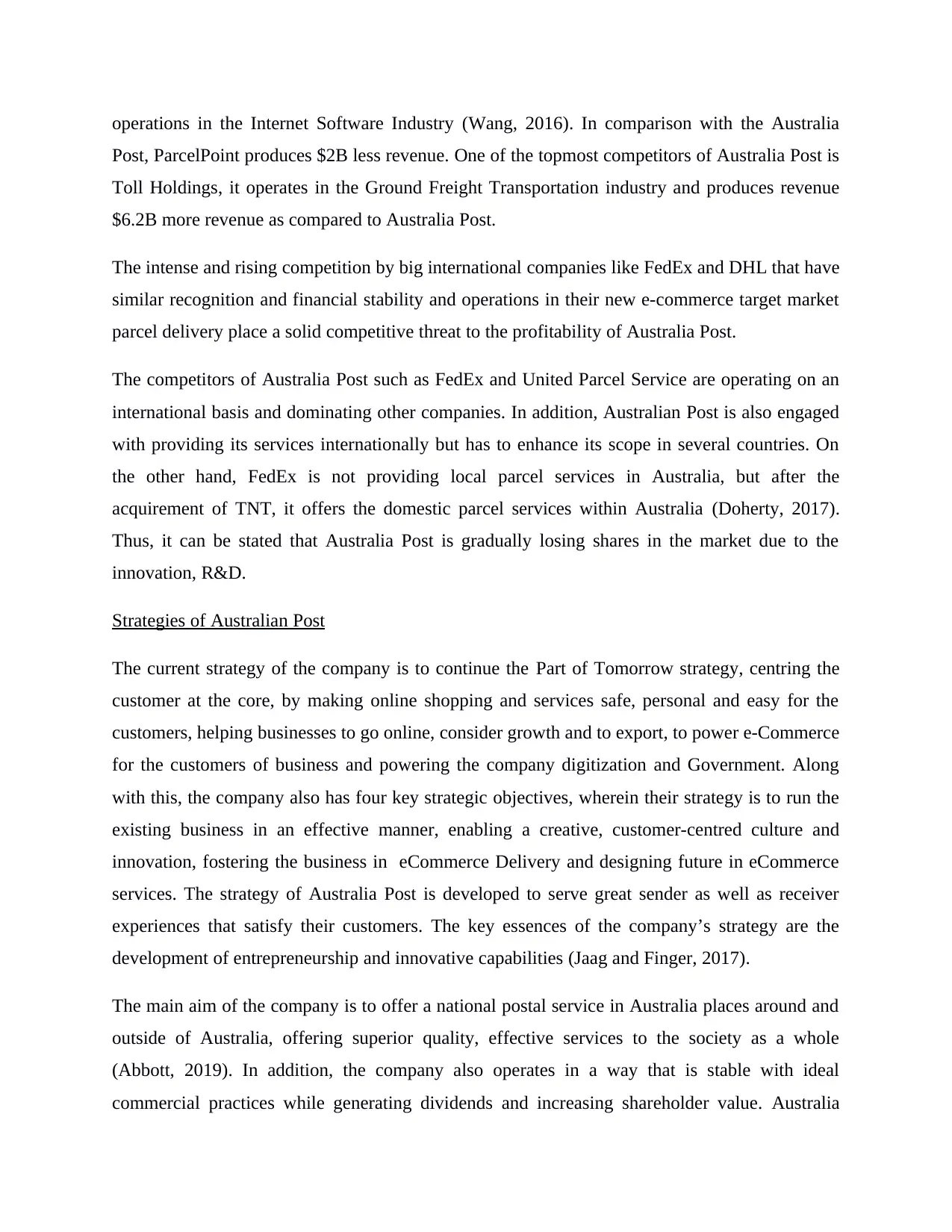
operations in the Internet Software Industry (Wang, 2016). In comparison with the Australia
Post, ParcelPoint produces $2B less revenue. One of the topmost competitors of Australia Post is
Toll Holdings, it operates in the Ground Freight Transportation industry and produces revenue
$6.2B more revenue as compared to Australia Post.
The intense and rising competition by big international companies like FedEx and DHL that have
similar recognition and financial stability and operations in their new e-commerce target market
parcel delivery place a solid competitive threat to the profitability of Australia Post.
The competitors of Australia Post such as FedEx and United Parcel Service are operating on an
international basis and dominating other companies. In addition, Australian Post is also engaged
with providing its services internationally but has to enhance its scope in several countries. On
the other hand, FedEx is not providing local parcel services in Australia, but after the
acquirement of TNT, it offers the domestic parcel services within Australia (Doherty, 2017).
Thus, it can be stated that Australia Post is gradually losing shares in the market due to the
innovation, R&D.
Strategies of Australian Post
The current strategy of the company is to continue the Part of Tomorrow strategy, centring the
customer at the core, by making online shopping and services safe, personal and easy for the
customers, helping businesses to go online, consider growth and to export, to power e-Commerce
for the customers of business and powering the company digitization and Government. Along
with this, the company also has four key strategic objectives, wherein their strategy is to run the
existing business in an effective manner, enabling a creative, customer-centred culture and
innovation, fostering the business in eCommerce Delivery and designing future in eCommerce
services. The strategy of Australia Post is developed to serve great sender as well as receiver
experiences that satisfy their customers. The key essences of the company’s strategy are the
development of entrepreneurship and innovative capabilities (Jaag and Finger, 2017).
The main aim of the company is to offer a national postal service in Australia places around and
outside of Australia, offering superior quality, effective services to the society as a whole
(Abbott, 2019). In addition, the company also operates in a way that is stable with ideal
commercial practices while generating dividends and increasing shareholder value. Australia
Post, ParcelPoint produces $2B less revenue. One of the topmost competitors of Australia Post is
Toll Holdings, it operates in the Ground Freight Transportation industry and produces revenue
$6.2B more revenue as compared to Australia Post.
The intense and rising competition by big international companies like FedEx and DHL that have
similar recognition and financial stability and operations in their new e-commerce target market
parcel delivery place a solid competitive threat to the profitability of Australia Post.
The competitors of Australia Post such as FedEx and United Parcel Service are operating on an
international basis and dominating other companies. In addition, Australian Post is also engaged
with providing its services internationally but has to enhance its scope in several countries. On
the other hand, FedEx is not providing local parcel services in Australia, but after the
acquirement of TNT, it offers the domestic parcel services within Australia (Doherty, 2017).
Thus, it can be stated that Australia Post is gradually losing shares in the market due to the
innovation, R&D.
Strategies of Australian Post
The current strategy of the company is to continue the Part of Tomorrow strategy, centring the
customer at the core, by making online shopping and services safe, personal and easy for the
customers, helping businesses to go online, consider growth and to export, to power e-Commerce
for the customers of business and powering the company digitization and Government. Along
with this, the company also has four key strategic objectives, wherein their strategy is to run the
existing business in an effective manner, enabling a creative, customer-centred culture and
innovation, fostering the business in eCommerce Delivery and designing future in eCommerce
services. The strategy of Australia Post is developed to serve great sender as well as receiver
experiences that satisfy their customers. The key essences of the company’s strategy are the
development of entrepreneurship and innovative capabilities (Jaag and Finger, 2017).
The main aim of the company is to offer a national postal service in Australia places around and
outside of Australia, offering superior quality, effective services to the society as a whole
(Abbott, 2019). In addition, the company also operates in a way that is stable with ideal
commercial practices while generating dividends and increasing shareholder value. Australia
Paraphrase This Document
Need a fresh take? Get an instant paraphrase of this document with our AI Paraphraser
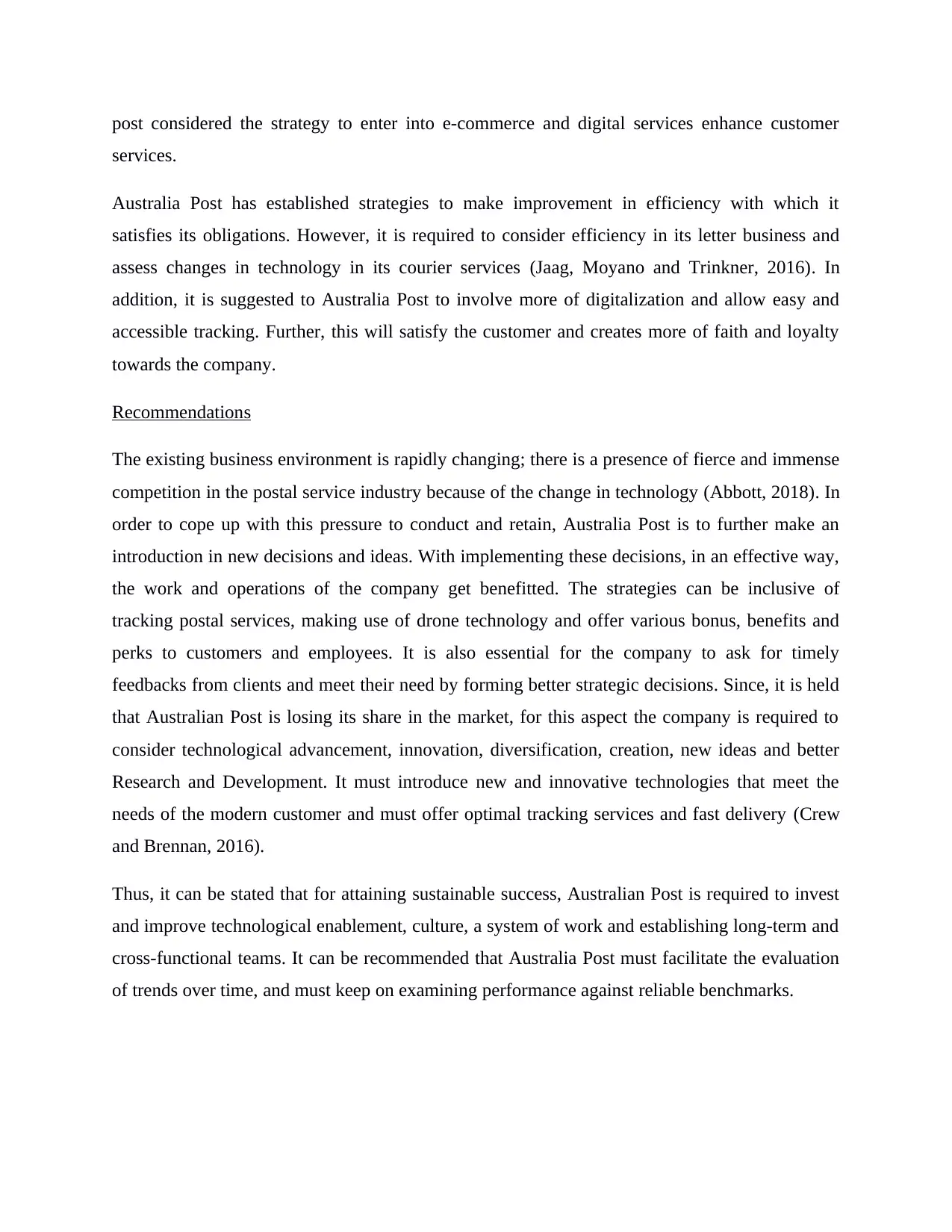
post considered the strategy to enter into e-commerce and digital services enhance customer
services.
Australia Post has established strategies to make improvement in efficiency with which it
satisfies its obligations. However, it is required to consider efficiency in its letter business and
assess changes in technology in its courier services (Jaag, Moyano and Trinkner, 2016). In
addition, it is suggested to Australia Post to involve more of digitalization and allow easy and
accessible tracking. Further, this will satisfy the customer and creates more of faith and loyalty
towards the company.
Recommendations
The existing business environment is rapidly changing; there is a presence of fierce and immense
competition in the postal service industry because of the change in technology (Abbott, 2018). In
order to cope up with this pressure to conduct and retain, Australia Post is to further make an
introduction in new decisions and ideas. With implementing these decisions, in an effective way,
the work and operations of the company get benefitted. The strategies can be inclusive of
tracking postal services, making use of drone technology and offer various bonus, benefits and
perks to customers and employees. It is also essential for the company to ask for timely
feedbacks from clients and meet their need by forming better strategic decisions. Since, it is held
that Australian Post is losing its share in the market, for this aspect the company is required to
consider technological advancement, innovation, diversification, creation, new ideas and better
Research and Development. It must introduce new and innovative technologies that meet the
needs of the modern customer and must offer optimal tracking services and fast delivery (Crew
and Brennan, 2016).
Thus, it can be stated that for attaining sustainable success, Australian Post is required to invest
and improve technological enablement, culture, a system of work and establishing long-term and
cross-functional teams. It can be recommended that Australia Post must facilitate the evaluation
of trends over time, and must keep on examining performance against reliable benchmarks.
services.
Australia Post has established strategies to make improvement in efficiency with which it
satisfies its obligations. However, it is required to consider efficiency in its letter business and
assess changes in technology in its courier services (Jaag, Moyano and Trinkner, 2016). In
addition, it is suggested to Australia Post to involve more of digitalization and allow easy and
accessible tracking. Further, this will satisfy the customer and creates more of faith and loyalty
towards the company.
Recommendations
The existing business environment is rapidly changing; there is a presence of fierce and immense
competition in the postal service industry because of the change in technology (Abbott, 2018). In
order to cope up with this pressure to conduct and retain, Australia Post is to further make an
introduction in new decisions and ideas. With implementing these decisions, in an effective way,
the work and operations of the company get benefitted. The strategies can be inclusive of
tracking postal services, making use of drone technology and offer various bonus, benefits and
perks to customers and employees. It is also essential for the company to ask for timely
feedbacks from clients and meet their need by forming better strategic decisions. Since, it is held
that Australian Post is losing its share in the market, for this aspect the company is required to
consider technological advancement, innovation, diversification, creation, new ideas and better
Research and Development. It must introduce new and innovative technologies that meet the
needs of the modern customer and must offer optimal tracking services and fast delivery (Crew
and Brennan, 2016).
Thus, it can be stated that for attaining sustainable success, Australian Post is required to invest
and improve technological enablement, culture, a system of work and establishing long-term and
cross-functional teams. It can be recommended that Australia Post must facilitate the evaluation
of trends over time, and must keep on examining performance against reliable benchmarks.
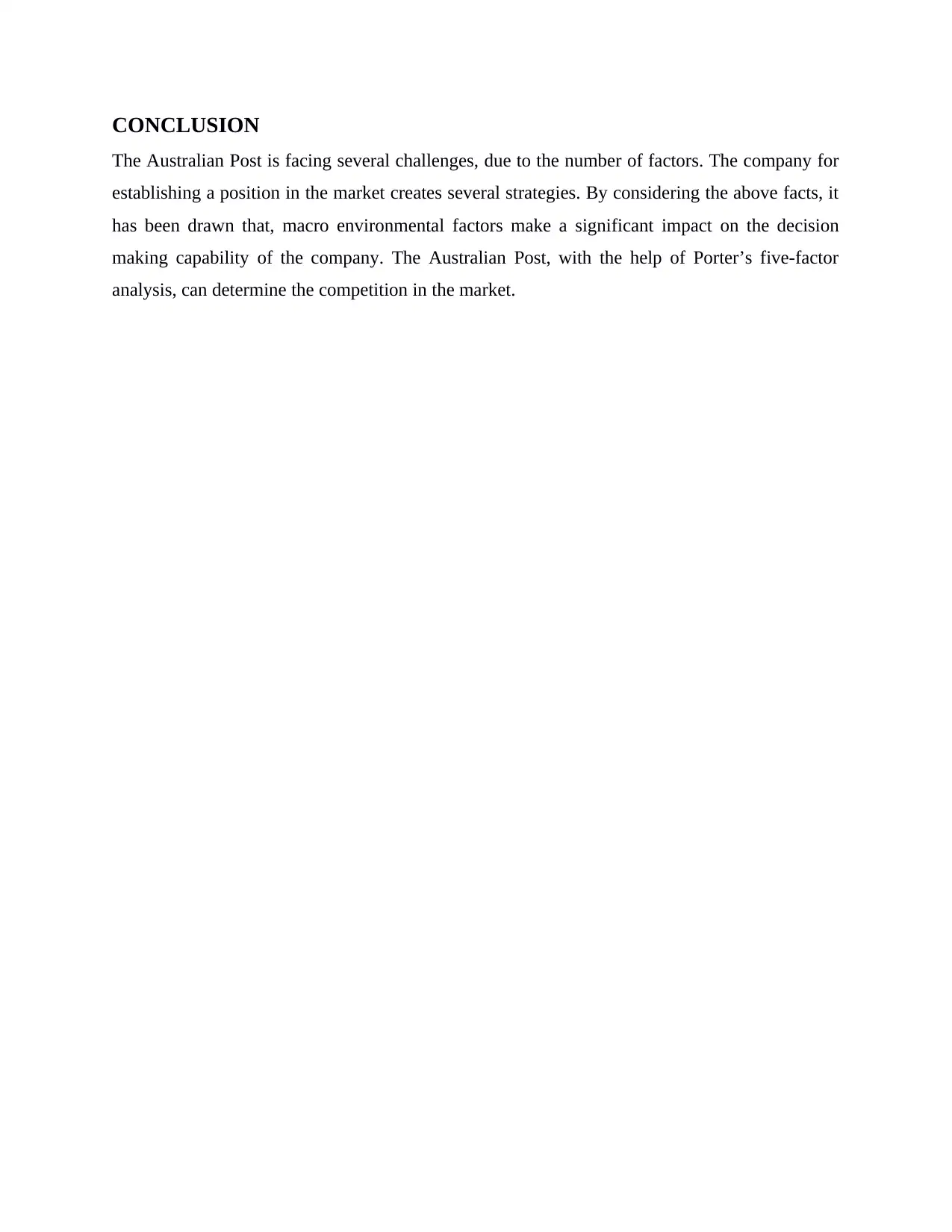
CONCLUSION
The Australian Post is facing several challenges, due to the number of factors. The company for
establishing a position in the market creates several strategies. By considering the above facts, it
has been drawn that, macro environmental factors make a significant impact on the decision
making capability of the company. The Australian Post, with the help of Porter’s five-factor
analysis, can determine the competition in the market.
The Australian Post is facing several challenges, due to the number of factors. The company for
establishing a position in the market creates several strategies. By considering the above facts, it
has been drawn that, macro environmental factors make a significant impact on the decision
making capability of the company. The Australian Post, with the help of Porter’s five-factor
analysis, can determine the competition in the market.
⊘ This is a preview!⊘
Do you want full access?
Subscribe today to unlock all pages.

Trusted by 1+ million students worldwide
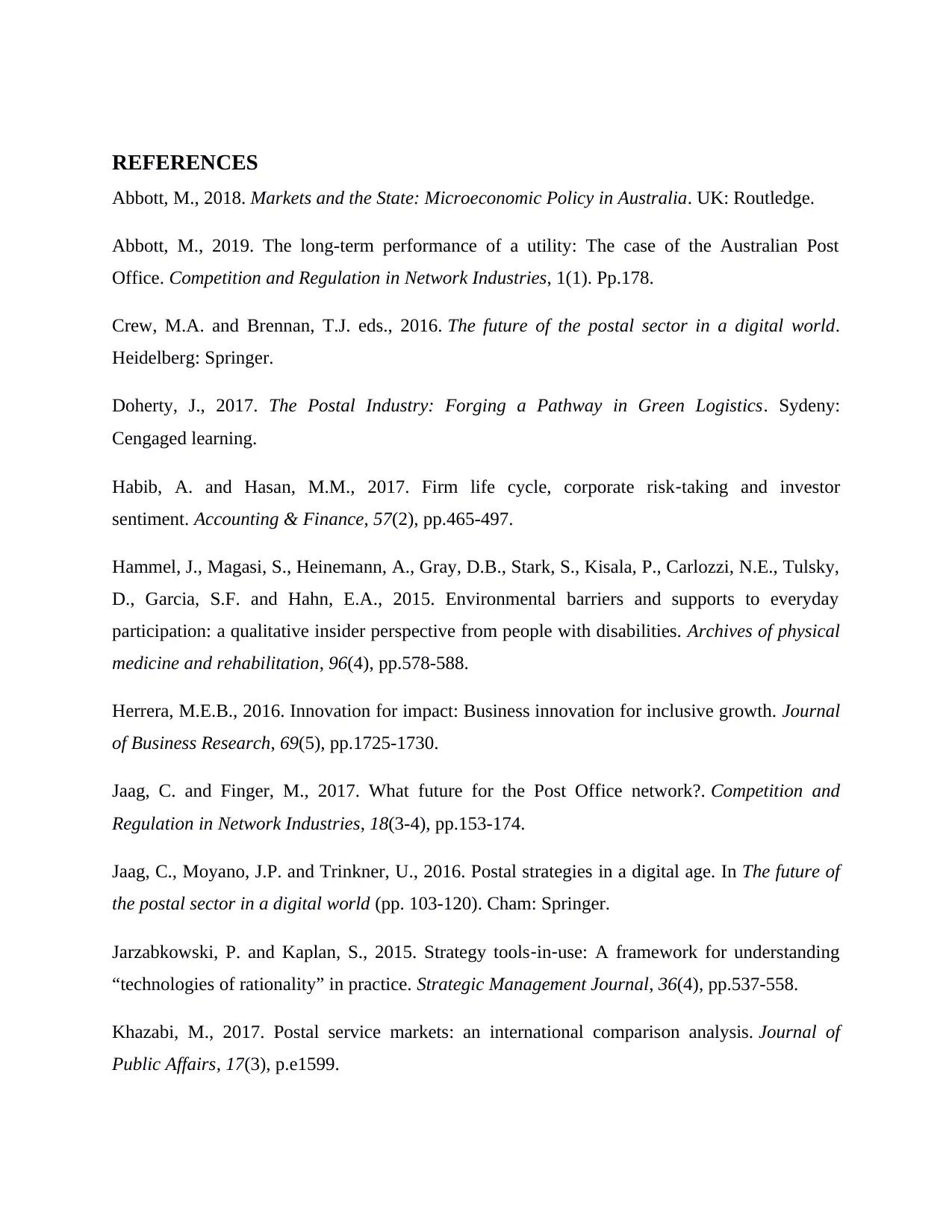
REFERENCES
Abbott, M., 2018. Markets and the State: Microeconomic Policy in Australia. UK: Routledge.
Abbott, M., 2019. The long-term performance of a utility: The case of the Australian Post
Office. Competition and Regulation in Network Industries, 1(1). Pp.178.
Crew, M.A. and Brennan, T.J. eds., 2016. The future of the postal sector in a digital world.
Heidelberg: Springer.
Doherty, J., 2017. The Postal Industry: Forging a Pathway in Green Logistics. Sydeny:
Cengaged learning.
Habib, A. and Hasan, M.M., 2017. Firm life cycle, corporate risk‐taking and investor
sentiment. Accounting & Finance, 57(2), pp.465-497.
Hammel, J., Magasi, S., Heinemann, A., Gray, D.B., Stark, S., Kisala, P., Carlozzi, N.E., Tulsky,
D., Garcia, S.F. and Hahn, E.A., 2015. Environmental barriers and supports to everyday
participation: a qualitative insider perspective from people with disabilities. Archives of physical
medicine and rehabilitation, 96(4), pp.578-588.
Herrera, M.E.B., 2016. Innovation for impact: Business innovation for inclusive growth. Journal
of Business Research, 69(5), pp.1725-1730.
Jaag, C. and Finger, M., 2017. What future for the Post Office network?. Competition and
Regulation in Network Industries, 18(3-4), pp.153-174.
Jaag, C., Moyano, J.P. and Trinkner, U., 2016. Postal strategies in a digital age. In The future of
the postal sector in a digital world (pp. 103-120). Cham: Springer.
Jarzabkowski, P. and Kaplan, S., 2015. Strategy tools‐in‐use: A framework for understanding
“technologies of rationality” in practice. Strategic Management Journal, 36(4), pp.537-558.
Khazabi, M., 2017. Postal service markets: an international comparison analysis. Journal of
Public Affairs, 17(3), p.e1599.
Abbott, M., 2018. Markets and the State: Microeconomic Policy in Australia. UK: Routledge.
Abbott, M., 2019. The long-term performance of a utility: The case of the Australian Post
Office. Competition and Regulation in Network Industries, 1(1). Pp.178.
Crew, M.A. and Brennan, T.J. eds., 2016. The future of the postal sector in a digital world.
Heidelberg: Springer.
Doherty, J., 2017. The Postal Industry: Forging a Pathway in Green Logistics. Sydeny:
Cengaged learning.
Habib, A. and Hasan, M.M., 2017. Firm life cycle, corporate risk‐taking and investor
sentiment. Accounting & Finance, 57(2), pp.465-497.
Hammel, J., Magasi, S., Heinemann, A., Gray, D.B., Stark, S., Kisala, P., Carlozzi, N.E., Tulsky,
D., Garcia, S.F. and Hahn, E.A., 2015. Environmental barriers and supports to everyday
participation: a qualitative insider perspective from people with disabilities. Archives of physical
medicine and rehabilitation, 96(4), pp.578-588.
Herrera, M.E.B., 2016. Innovation for impact: Business innovation for inclusive growth. Journal
of Business Research, 69(5), pp.1725-1730.
Jaag, C. and Finger, M., 2017. What future for the Post Office network?. Competition and
Regulation in Network Industries, 18(3-4), pp.153-174.
Jaag, C., Moyano, J.P. and Trinkner, U., 2016. Postal strategies in a digital age. In The future of
the postal sector in a digital world (pp. 103-120). Cham: Springer.
Jarzabkowski, P. and Kaplan, S., 2015. Strategy tools‐in‐use: A framework for understanding
“technologies of rationality” in practice. Strategic Management Journal, 36(4), pp.537-558.
Khazabi, M., 2017. Postal service markets: an international comparison analysis. Journal of
Public Affairs, 17(3), p.e1599.
Paraphrase This Document
Need a fresh take? Get an instant paraphrase of this document with our AI Paraphraser
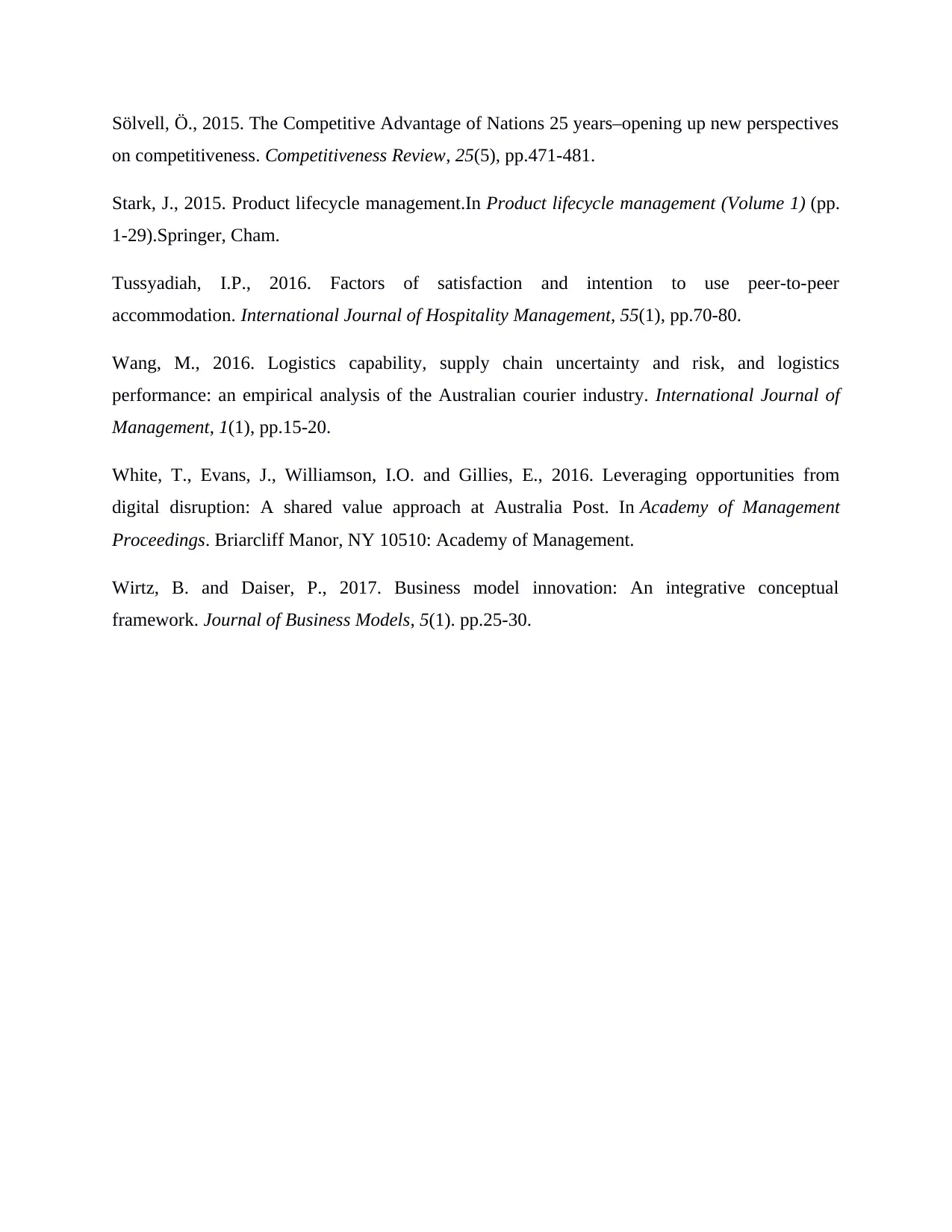
Sölvell, Ö., 2015. The Competitive Advantage of Nations 25 years–opening up new perspectives
on competitiveness. Competitiveness Review, 25(5), pp.471-481.
Stark, J., 2015. Product lifecycle management.In Product lifecycle management (Volume 1) (pp.
1-29).Springer, Cham.
Tussyadiah, I.P., 2016. Factors of satisfaction and intention to use peer-to-peer
accommodation. International Journal of Hospitality Management, 55(1), pp.70-80.
Wang, M., 2016. Logistics capability, supply chain uncertainty and risk, and logistics
performance: an empirical analysis of the Australian courier industry. International Journal of
Management, 1(1), pp.15-20.
White, T., Evans, J., Williamson, I.O. and Gillies, E., 2016. Leveraging opportunities from
digital disruption: A shared value approach at Australia Post. In Academy of Management
Proceedings. Briarcliff Manor, NY 10510: Academy of Management.
Wirtz, B. and Daiser, P., 2017. Business model innovation: An integrative conceptual
framework. Journal of Business Models, 5(1). pp.25-30.
on competitiveness. Competitiveness Review, 25(5), pp.471-481.
Stark, J., 2015. Product lifecycle management.In Product lifecycle management (Volume 1) (pp.
1-29).Springer, Cham.
Tussyadiah, I.P., 2016. Factors of satisfaction and intention to use peer-to-peer
accommodation. International Journal of Hospitality Management, 55(1), pp.70-80.
Wang, M., 2016. Logistics capability, supply chain uncertainty and risk, and logistics
performance: an empirical analysis of the Australian courier industry. International Journal of
Management, 1(1), pp.15-20.
White, T., Evans, J., Williamson, I.O. and Gillies, E., 2016. Leveraging opportunities from
digital disruption: A shared value approach at Australia Post. In Academy of Management
Proceedings. Briarcliff Manor, NY 10510: Academy of Management.
Wirtz, B. and Daiser, P., 2017. Business model innovation: An integrative conceptual
framework. Journal of Business Models, 5(1). pp.25-30.
1 out of 11
Related Documents
Your All-in-One AI-Powered Toolkit for Academic Success.
+13062052269
info@desklib.com
Available 24*7 on WhatsApp / Email
![[object Object]](/_next/static/media/star-bottom.7253800d.svg)
Unlock your academic potential
Copyright © 2020–2025 A2Z Services. All Rights Reserved. Developed and managed by ZUCOL.





